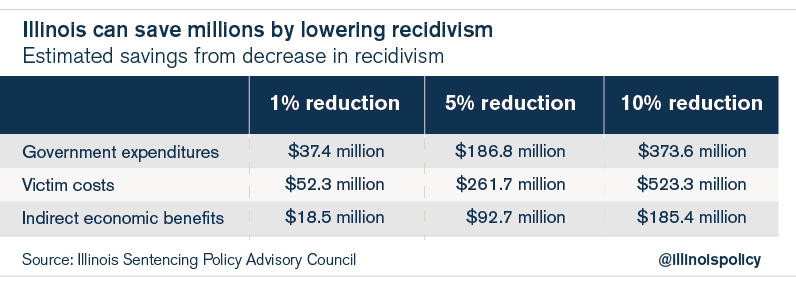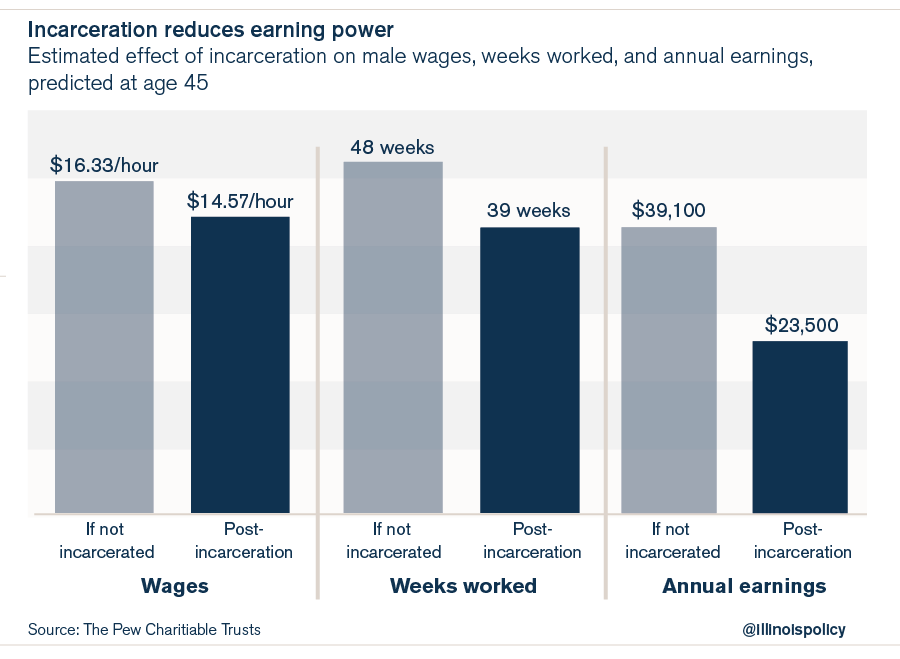Reforms that get ex-offenders back to work – and keep them out of jail – could save Illinois millions
Even a very small reduction in recidivism – just 5 percent – would save Illinois taxpayers nearly $187 million over nine years. But if Illinois’ recidivism rate stays the same, taxpayers will pay approximately $5.7 billion for recidivism costs over the next five years.
Illinois has a costly criminal-justice system. The state spent $1.4 billion on prisons in 2015. Costs increased as the prison population exploded by over 300 percent between 1978 and 2013, leading Illinois to have the most overcrowded prison system in the U.S. by the end of 2014.
Too much of that money is spent on people who cycle in and out of the system, many of whom cannot find meaningful work to support themselves and their families. In Illinois, over 45 percent of offenders released from prison each year will have returned three years later.
To save on recurring incarceration costs, policymakers need to target this population as a way to cut back on prison spending, but more importantly, to make the most of the state’s human capital.
Why do so many former offenders return to crime? One reason is a lack of employment. Without work, former offenders are likelier to resort to crime to make ends meet, perpetuating a cycle of recidivism.
Taxpayers pay a high cost for recidivism. Each time an ex-offender ends up back behind bars, it costs the state, on average, approximately $118,746, according to a report by the Illinois Sentencing Policy Advisory Council.
The report breaks down this average cost into three parts: Taxpayers cover $40,987 by paying for arrests, trials, court proceedings, incarceration and supervision; $57,418 of the cost is borne by victims who have been deprived of property, incurred medical expenses, lost wages, and endured pain and suffering; and another $20,432 comes from indirect costs in foregone economic activity.
Assuming Illinois’ recidivism rate stays the same, taxpayers themselves will pay approximately $5.7 billion for recidivism costs over the next five years.
But even small reductions in repeat offending can lead to substantial savings. If the right policies led to a reduction in recidivism of just 1 percent, Illinois would save $37.4 million in prison, court and policing costs over nine years. If the recidivism rate fell by 5 percent, these savings would jump to nearly $187 million over nine years, along with $93 million in avoided economic losses and $262 million in victimization costs not incurred.

And just as important as financial costs are the social costs of not prioritizing rehabilitation and employment. Nearly 70,000 children have a parent in Illinois prisons at any given time, which means that likely hundreds of thousands of children have parents with felony records. The sad reality is that children with incarcerated parents are more likely to experience economic hardship and to become involved in the criminal-justice system themselves.
Given the high cost of repeat offenses to taxpayers, crime victims and offenders’ families, and the considerable social benefits and savings that could result from effective strategies to reduce recidivism, the public should welcome new policies that discourage crime by encouraging productive employment.
Important re-entry reforms include:
- Sealing expansion: Allow most nonviolent offenders the chance to apply to have their criminal records sealed as soon as they successfully complete their prison sentences or parole, if applicable.
- Business-liability reform: Protect businesses from lawsuits based solely on hiring an employee with a criminal record.
- Occupational-licensing reform: Remove legal barriers that prevent former offenders from working in most licensed occupations.
When government makes it excessively difficult for ex-offenders to find work, it exacerbates the problems ex-offenders have reintegrating into society and becoming self-sufficient. Even when former offenders do find jobs, they have lower estimated annual earning power than typical workers: An ex-offender will earn about $15,600 less per year than someone who has never been incarcerated, according to research by The Pew Charitable Trusts.

Survey data have suggested that as many as 60 to 75 percent of former offenders are unemployed a year after their release. There is an urgent need to remove the barriers to work that limit options for people who’ve already completed their sentences.
The fiscal and societal costs of unemployment and underemployment among ex-offenders are staggering for former offenders, their families and the public. Illinois needs new approaches to bring down these costs.
